August 10, 2017- Volume 19, Issue 6: Speaking on Energy Resiliency
IN THIS ISSUE
Flanigan’s Eco-Logic
Visiting the Cuttyhunk Microgrid
California’s Cap and Trade Extended
JPMorgan Chase Makes Major Renewable Energy Commitment
Wind Update: Humpbacks and Wind
Cancelling Nukes in South Carolina
First Florida City Signs Solar Ordinance
Solar Co-ops Community Power Network Style!

Flanigan’s Eco-Logic: Energy Resiliency in Santa Monica
This past week I was pleased to be part of another successful Solar Santa Monica event. EcoMotion has run the Solar Santa Monica program for ten years, and now we’re pushing into new waters… specifically the nexus between solar power, climate protection, and energy resilience. Santa Monica has appointed its first Chief Resiliency Officer (CRO). Pretty cool.
Drew Lowell-Britt from my staff had taken the lead organizing the event. He’d invited vendors to table, established an Eventbrite invitation plus a social media strategy, and prepared and sent blasts within Santa Monica. Quickly the late morning event was gaining attention. This next evolution in the solar + storage paradigm is of great interest.
Humbled I was by the caliber of the registrants. Battery providers including Sonnen and STEM wanted to participate; XERO Solar and PermaCity Solar were on hand. The meeting/town hall was held at Santa Monica’s impressive City Library. Interested citizens began to fill the MLK Auditorium. My job was to educate and enthuse. No pressure!
Many solar system owners assume that when the grid goes down, they will have power. Not true in almost all cases. To become resilient to outages, I explained that you need some form of generation, plus storage and controls. The 40-minute talk focused on today’s potential in Santa Monica for energy resiliency thanks to abundant sunshine, a new class of batteries, and sophisticated microgrids.
Quote of the Week:
“Thanks to bipartisan support California was able to extend its historic cap and trade program which protects our environment and preserves our nation-leading economic growth… I hope politicians around the country can learn from the example set in Sacramento last week.”
– Former California Governor Arnold Schwarzenegger
Visiting the Cuttyhunk Microgrid
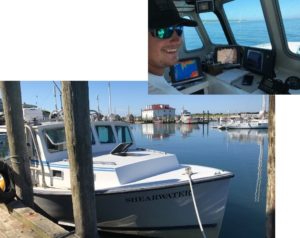
Transportation to Cuttyhunk Island
Just behind Larsen’s fish market in Menemsha we meet… on the docks where seasoned fishing boats unload their catches. Tucker fires up the Shearwater’s mighty diesel engines. He’s our captain for the day. The boat rattles and roars, a 34-foot commercial fishing vessel that reeks of fish. No messing around: It has an eight-foot tailgate to bring in lobster pots and big catches. It’s old and weathered many high seas, and thousands and thousands of pounds of fish.
This is easy duty for our captain, a young man with a wide grin who loves his summer job on board the Shearwater. In the off-season, he’s at a maritime academy and makes very clear his great love of fishing, both commercially and for charters. This is an early morning crossing… heading out of Menemsha, across the Vineyard Sound, through a channel in the Elizabeth Islands, and south to Cuttyhunk… our destination.
The trip takes an hour. Clear sailing: The seas are relatively calm; sun is shining strong. Over the roar of the engines, Tucker shows me the boat’s navigation – its autopilot. But he’s careful and at the helm, noting the recent ferry crash in Hyannis. He navigates his three monitors and shows me maps of subseas; pointing out canyons on the sea floor that channel currents rich with nutrients to the surface, attracting larger fish, and in turn fishermen eager for rich harvests.
 After an hour of deafening racket, Tucker eases off the throttle, and we slide past the Cuttyhunk breakwater and into the idyllic harbor alive with boaters of all kinds. We’re on schedule and our host, Wyatt Garfield, waves from the dock.
After an hour of deafening racket, Tucker eases off the throttle, and we slide past the Cuttyhunk breakwater and into the idyllic harbor alive with boaters of all kinds. We’re on schedule and our host, Wyatt Garfield, waves from the dock.
Cuttyhunk, the site of a converted microgrid. For years, the island has been powered by diesel generators. Some 40 years ago, the diesel-only microgrid was augmented by wind. That’s long gone. Today power costs 60 cents per kilowatt hour on the island. But the population has never justified an undersea power cable – like the one that serves Martha’s Vineyard – and diesel is brought in by boat like everything else. A water taxi comes 14 miles in from New Bedford daily in summer, infrequently in winter.
Cuttyhunk is 500 acres in size. Today about three-quarters of the island is owned by one family, descendants of the Wood family. The Woods owned American Woolen, a textile company that operated 60 mills in eight states, and began purchasing land on Cuttyhunk in 1905, buying two large parcels and building a summer residence. They financed the town sewer system and were widely seen as a steward of the land.
It was in that capacity that a descendent of the Woods named Allen Spaulding spearheaded the construction of a wind turbine on Cuttyhunk in the 1970s. The world at the time was in the grip of the OPEC oil embargo and prices for diesel fuel had doubled. Spaulding’s idea was to augment the diesel power generator with wind, in fact, the largest system in the country at that time.
The wind turbine was built by Wind Turbine Generator (WTG) Energy Systems in 1975. It was mounted on a 25-meter lattice tower, had a 10-meter diameter rotor with stall flaps at the tips, and it was upwind facing. Cuttyhunk was on the map! Cuttyhunk had one of the world’s first wind/diesel microgrid systems.
According to the story, Spaulding left a career as an artist to become president of WTG. But the turbine did not prove reliable, there were claims of radio interference and disturbing resonant sounds, low frequency acoustic impules” that made people feel nautious and dizzy, not to mention the irritation and headaches. So the last of a series of three turbines were taken down, and the island reverted to its diesel generators. In 2013, Spaulding died in a plane crash on the island as he was taking off from his private airfield on Cuttyhunk.
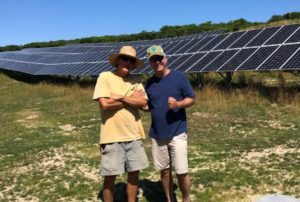 Currently, there are 174 electric meters on the island, serving a summer population of about 250, with a year-round population of less than 50. And it gets cold and dark in the winter. Peak demand on the island is ~250 kW. That’s when most residents are here in summer, the single hotel is busiest, and the bustling port provides shore power for yachts that tie up in the harbor’s slips.
Currently, there are 174 electric meters on the island, serving a summer population of about 250, with a year-round population of less than 50. And it gets cold and dark in the winter. Peak demand on the island is ~250 kW. That’s when most residents are here in summer, the single hotel is busiest, and the bustling port provides shore power for yachts that tie up in the harbor’s slips.
Wyatt is island calm. He meets us at the fishing dock where we also meet his fellow electric power commissioner. It’s a busy morning for the microgrid; a technician from Princeton Power is just arriving to reprogram the system’s controls. We’ll chat with them later.
It’s a family energy tour, Flanigan-style! There are six of us, two daughters, a brother, nephew and his wife… all Flanigans. Wyatt walks at a brisk pace from the pier to the site of the Cuttyhunk electric system… a very small facility. Some kind of glitch has a back-up diesel generator working unnecessarily. And that’s after a record eight days of no diesel back-up at all, in the height of summer. Cuttyhunk’s microgrid is well designed, and providing for summer peak use using solar plus storage.
Today, Cuttyhunk features a carbon-free microgrid, with diesel back-up, an enviable configuration. Thanks to a U.S. Department of Agriculture grant, Cuttyhunk was awarded a $2.1 million grant to convert its power system from 100% diesel to carbon-free. The island community only had to pay a $160,000 shortfall price. With saved fuel costs the system will likely pay for itself in just a few years. After that, notes Wyatt, his commission expects to be able to lower the kWh cost for island residents.
We walk into the unassuming “power plant” where the island has housed four diesel generators for some time. Fuel for power has been the community’s third largest expense. So efforts have been made to conserve. Years ago everyone was encouraged to replace inefficient refrigerators; more recently there was a push to convert home’s to LED lighting. These concerted efforts have reduced loads and enabled the carbon-free microgrid.
Our posse heads up to the solar system, a 350 kW ground-mounted system tucked away in an unobtrusive spot. The array is impressive; there’s a stack of SolarWorld panels to the side; no need for security here on this remote island. We check the racking, combiner, the inverter… The system was energized in April of this year, the system generating power that feeds the microgrid and its 1.25 MWh battery storage system. The system was built on private property; the community pays the landowner $1,800 a month for the use of the site.
As we stroll our guide and ambassador points out the island’s features; he tells us that he retired from a career in retail in Maine. He now spends entire summers in Cuttyhunk with his wife and visiting children and grandchildren. He’s building a new home here and the windows just were shipped in.
We get back to the power system. A dilemma facing the utility is excess solar power in winter and potentially shoulder seasons. This is not net energy metering country! There is no power grid, no ISO, to address seasonal variations in generation and use. We chat about resistance heating, heat pumps, perhaps electrolysis and hydrogen production… ways of using the excess without fostering wasteful habits. Solar was considered best since production maxes in summer when it’s needed the most. Wind, on the other hand, would have been prolific year-round.
Cuttyhunk has a one-room schoolhouse, and church that Wyatt point out. He recounts with a sparkle in his eye that he was married there some years ago. There’s a museum, a few restaurants. We buy lemonade from kids outside the island’s sole market. As we walk the community, we see transformers that knock down the microgrid’s voltage from 480 to 220 volts for household use.
Wyatt has been most generous with his time. We thank him heartily. Now he’s got to get back to his wife and grandchildren. He points out the road to the best viewing spot on the island, Lookout Hill. Go up there he said and we did. It couldn’t have been more post-card perfect. With 360-degree views where we snap many photos, then head down to the marina and wrap our micro-island experience at its raw-bar on the pier, oysters, stuffed scallops, and chowder.
We’re pretty quiet on the way back. The engine roars, the boat rattles and pounds its way through the seas. We’re all imagining island life, or what it takes to be an islander… day in and day out. And then I chat with Tucker – we’re on cruise control and he wants to talk fish again. Imagine. Nothing like getting your limit of stripers!
California’s Cap and Trade Extended
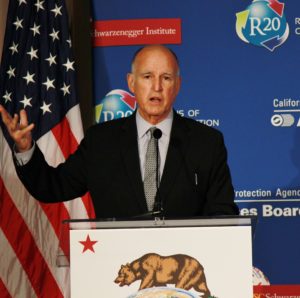 The extension of California’s Cap and Trade program through AB 398 is a big win for California, and for Californians. California’s cap-and-trade program uses a market-based mechanism to lower greenhouse gas emissions. Now the program will be extended through 2030, a major means to fulfill the State’s commitment to lower greenhouse gas emissions by 40% below 1990 levels by 2030.
The extension of California’s Cap and Trade program through AB 398 is a big win for California, and for Californians. California’s cap-and-trade program uses a market-based mechanism to lower greenhouse gas emissions. Now the program will be extended through 2030, a major means to fulfill the State’s commitment to lower greenhouse gas emissions by 40% below 1990 levels by 2030.
California’s Cap-and-Trade rules came into effect on January 1, 2013 and have applied to large electric power plants and large industrial plants. In 2015, the rules were extended to distributors of heating and transportation fuels. Then, the program encompassed ~ 360 California businesses and nearly 85% of the state’s total greenhouse gas emissions. In January 2014, California’s program was linked to Québec’s program.
Under a cap-and-trade system, companies must hold enough emission allowances to cover their emissions. They are free to buy and sell allowances. California held its first auction of greenhouse gas allowances on November 14, 2012.
While the market mechanism makes sense, it has been fraught with challenges. One of the biggest is who gets the money generated. Everyone wants it. The Governor has been pushing for its use to fund California’s High Speed Rail project. Other fight for EJ… environmental justice… and using Cap and Trade revenues to offset years of local air pollution, for instance communities bisected by highways and homes close to industry.
Perhaps the most remarkable aspect of the bill’s passage was its bipartisan nature. May it be a lesson to Washington. Assembly Republican Leader Mayes spent months expressing interest in negotiating with Gov. Jerry Brown and other Democrats on an extension of cap-and-trade, the state’s signature climate change program.
After helping to secure a number of amendments that would make the law more amenable to the industries most directly affected by its regulations, and possibly give Republicans more of a say in how revenues are spent, Mayes delivered seven critical votes that pushed it over a necessary two-thirds threshold in the Assembly. Apparently a wave of conservative backlash since the vote could cost him his post as head of the Assembly’s 25-member GOP caucus.
The Governor signed the legislation on Treasure Island, the same location where Governor Arnold Schwarzenegger signed AB 32 (the California Global Warming Solutions Act of 2006), which authorized the state’s cap-and-trade program more than a decade ago. AB 398 strengthens and extends the state’s cap-and-trade program, which would have expired without legislative action. According to experts, it also enhances the original legislation: It cuts the use of out-of-state carbon offsets and brings those environmental benefits back to California. It prioritizes cap-and-trade spending to ensure funds go where they are needed most, including reducing diesel emissions in the most impacted communities. And its companion bill, AB 617 makes provisions to reduce air contaminants in California’s most polluted cities.
Extending California’s cap-and-trade program ensures that billions of dollars in auction proceeds continue flowing to communities across California. To date, these investments have preserved and restored tens of thousands of acres of open space, helped plant thousands of new trees, funded 30,000 energy efficiency improvements in homes, expanded affordable housing, boosted public transit, and helped more than 100,000 Californians purchase zero-emission vehicles.
JPMorgan Chase Makes Major Renewable Energy Commitment

Solar at the Entrance of Chase Field in Phoenix
JPMorgan Chase – a financial services giant and the world’s third largest bank — plans to buy renewable power for 100% of its global energy needs by 2020, and to facilitate $200 billion in clean financing through 2025 – the largest commitment by any global financial institution to date.
JPMorgan Chase announced that it will fulfill its renewable power commitment through 2020 both on-site installations of solar and procuring power from utility-scale projects. This includes installing solar on up to 1,400 retail buildings that it owns, as well as its 40 commercial buildings. The company will begin a pilot installation of solar panels at Chase branches in California and New Jersey.
Already, a division of JPMorgan Chase has signed a 20-year power purchase agreement with NRG for a 100 MW wind project that is expected to go online by the end of this year. Green power purchases will be complemented be enhanced energy efficiency measures, including switching to LEDs for lighting and installing systems to manage building energy use.
JPMorgan Chase also announced its plan to facilitate $200 billion in clean energy financing by 2025. While details on this part of the plan are forthcoming, the investments will likely center around the company’s 22,000 corporate and investment clients. In 2016, the company provided $2 billion in tax equity for wind, solar, and geothermal projects.
Wind Update: Humpbacks and Wind
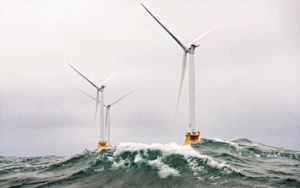 Wind turbines kill roughly 300,000 birds each year. Compared to an estimated 3.7 billion slain by cats each year, and depending on your perspective, a tiny fraction of the total. Yet avian deaths remain a key issue raised by renewable energy critics. Our President has suggested that wind turbines kill eagles, and lots of them.
Wind turbines kill roughly 300,000 birds each year. Compared to an estimated 3.7 billion slain by cats each year, and depending on your perspective, a tiny fraction of the total. Yet avian deaths remain a key issue raised by renewable energy critics. Our President has suggested that wind turbines kill eagles, and lots of them.
Now right-wing skeptics seek to tie the recent death of a humpback whale in Rhode Island to the nation’s first offshore wind farm. The Daily Caller, a news site founded by a Fox News personality, published a story suggesting that noise from the turbines caused a 32-foot juvenile humpback male to beach itself and die.
The necropsy ordered by the Mystic Aquarium & Institute for Exploration, which handled the carcass, may or may not be able to identify a connection between sound emitted by turbines and the death. A number of stressors may be to blame. The whale washed up the same week two other humpback whales died after stranding on Cape Cod. The deaths are part of a larger trend. Since January 2016, 48 humpback whales have died along the East Coast between North Carolina and Maine according to the National Oceanic and Atmospheric Administration (NOAA). Earlier this year, the agency declared an “unusual mortality event” and launched an investigation.
Block Island Wind’s construction was completed nearly a year ago. Its developers readily admit that the turbines do produce low noise levels when the blades of structures, twice the height of the 305-foot Statue of Liberty, spin. Deepwater Wind officials there note that, “Compared to ferries and cargo ships and any other kind of vessel in the water, the wind farm creates a very, very low level of vibration and sound underwater.”
Offshore wind has huge potential for America. According to the National Renewable Energy Laboratory (NREL) in Golden, Colorado, winds off the coast of the U.S. could generate 4,223 gigawatts of power. That’s four times the amount of electricity that’s currently produced from all power sources in the country.
Cancelling Nuclear Reactors in South Carolina

Construction of Vogtle Unit 3
Santee Cooper and SCANA will abandon construction of two nuclear reactors at the Summer plant in South Carolina. The Santee Cooper board, which owns 45% of the project, voted unanimously in July to halt construction, citing costs officials said could reach over $25 billion. Problems with the reactor supplied by Toshiba subsidiary Westinghouse caused long delays and cost overruns. The 75% increase in the original cost estimate proved too much for Santee Cooper, which has had to raise rates five times to cover the cost of the project. SCE&G has raised rates nine times to cover Summer’s costs.
Originally proposed in 2007, the two-reactor expansion of the Summer plant was supposed to be completed by 2017 and 2018. But construction crews ran into problems with Westinghouse Electric’s AP1000 reactor design, causing delays and cost overruns that led the nuclear developer to file for bankruptcy in March. After taking over construction, the utilities said they would likely be unable to finish construction before the end of 2021, when a critical federal tax credit for nuclear energy expires.
The decision leaves only one nuclear plant under construction in the United States – Southern Company’s Vogtle nuclear project. That facility has experienced similar problems with reactor design and cost overruns, and Southern officials are expected to decide in August whether to terminate its construction.
First Florida City Signs Solar Ordinance
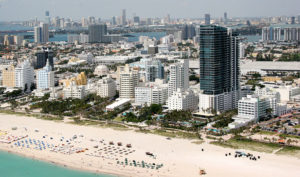
Miami Metro Area
The City of South Miami is the latest city to sign onto a new trend encouraging solar across the country: solar mandates. In July, the South Miami City Commission in a 4-1 vote approved a law requiring solar to be installed on all new homes. Thus South Miami became the first city in Florida with such a requirement, seeking to cost-effectively incorporate solar in new construction. Six California cities including Santa Monica and San Francisco have passed such mandates.
South Miami Mayor Philip Stoddard, a proponent of the ordinance, stated that, “Solar reduces the cost of home ownership, it makes houses sell faster, it returns more to a builder, it makes local jobs, and most importantly, it reduces carbon emissions today to help our children and grandchildren have a better future tomorrow.” A university professor, he notes that, “We’re down in South Florida where climate change and sea level rise are existential threats, so we’re looking for every opportunity to promote renewable energy… We have a pledge for carbon neutrality. We support the Paris Climate Agreement.”
Stoddard said he expects only a few new homes and other buildings to be built in South Miami this year because the city of about 11,000 is surrounded on all sides by dense urban development and has very little space for new construction. Under the rules, new residential construction would require 175 square feet of photovoltaics to be installed per 1,000 square feet of sunlit roof area, or one array with 2.75 kilowatt capacity per 1,000 square feet of living space, whichever is less. Houses built under existing trees may be exempt. Those opposed to the law generally like solar, but favored incentives instead of the mandate.
The new construction requirement complements the City’s push for existing homeowners to put solar on their roofs. In 2015, South Miami completed a competitive bid process for solar installations. The objective was to get the best possible and fixed pricing from one single solar installer. The City received responses from two contractors and then negotiated, volume and discounted pricing for solar panel installation on all types of residential and commercial roofs.
Solar Co-ops Community Power Network Style!
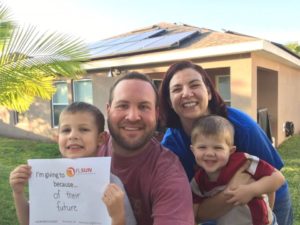
Family Participates in FL SUN
Anya Schoolman is the founder and Executive Director of Community Power Network, a DC-based national nonprofit that helps communities build and promote local renewable energy projects and policies. In 2007, Anya founded with Mt. Pleasant Solar Co-op with her son Walter after helping 45 neighbors in her Mount Pleasant neighborhood go solar. Anya then went on to foster the creation of 11 other solar co-ops in DC, eventually forming a city-wide organization DC Solar United Neighborhoods (DC SUN) to make solar accessible and affordable to all Washington DC residents.
In 2011, Anya founded Community Power Network, a national organization that supports grassroots, local, state, and national organizations working to build, and promote locally based renewable energy projects and policies. CPN has provided technical assistance to hundreds of citizens and organizations around the country. Community Power Network is currently supporting state projects in Washington, D.C. (DC SUN), Maryland, (MD SUN), Virginia (VA SUN), West Virginia (WV SUN), and Ohio (OH SUN).
Now Florida is getting into the action: This year, homeowners in Central Miami (South) – including the City of South Miami – formed a solar co-op to get discounts on solar systems. This one of several solar co-ops in Florida, including Seminole County, Broward County, and Orange County where over 550 homeowners signed up before the solicitation was closed. The Central Miami solar co-op was sponsored by the League of Women Voters Miami-Dade County, Green Corridor (Ygrene), and 14 other non-profit and government agencies. In each case, each participant signs his or her own contract with the installer, but everyone gets the bulk discount with published rates by size of system and roof type. The expectation has been to save up to 20% off the cost of a solar system.
